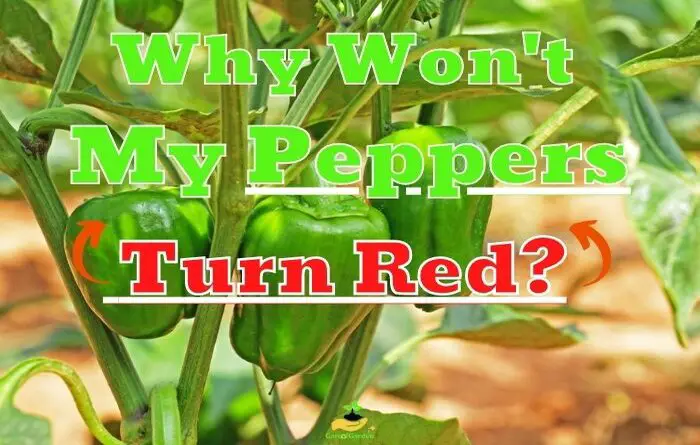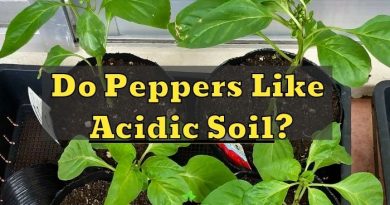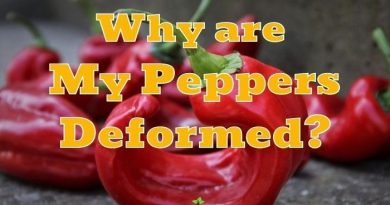Why Won’t My Peppers Turn Red? [5 Hidden Reasons]
Are you eagerly waiting for your peppers to turn red, but they seem to be stuck in their green stage? Don’t worry; you’re not alone. Many gardeners, including myself, face this frustrating dilemma of wondering why won’t my peppers turn red.
In this blog post, we’ll dive deep into the reasons behind it and explore some solutions to get those vibrant, juicy red peppers on your plate.”
The reasons peppers fail to turn red lie in a variety of reasons, including harvesting too early or unfavorable environmental factors such as lack of sunlight, low temperatures, water stress, nutrient deficiencies, overcrowding, and other agricultural mistakes. The type of soil the peppers are grown in and even the temperature can also play a role.
Reasons Why Peppers Won’t Turn Red
In this article you will discover multiple reasons peppers may not turn red, including different varieties and environmental factors.
1. Wrongly Selected Variety
One of the common mistakes of inexperienced gardeners is an attempt to grow a high-quality crop from seeds collected from store-bought vegetables. Beautiful and large peppers, which can be bought all year round in supermarkets, are imported from other countries or regions and some of these pepper varieties should not turn red.
First of all, it is worth checking which variety of pepper is chosen. Perhaps ripe peppers should not be red at all, but green or lilac. Therefore, if the peppers have acquired not red, but a yellow, orange or dark green hue, do not be surprised, this is a natural stage of development.
Depending on the varietal properties of pepper, it can have a shade from light green to bright purple and even chocolate. On the package with seeds, the instructions indicate the ripening period and the color of the vegetables at the stage of biological ripeness.
Some peppers, like sweet bell and jalapenos, will stay green even after ripe. The skin of these peppers will turn reddish-brown once they are cooked, but the inside will still be green.
Other peppers, like Anaheim and Poblano peppers, are usually picked when they are entirely red and have hard skin. When these peppers are cooked, their skins soften and fall off, revealing the red flesh underneath.
The climatic conditions of these regions are very different from the middle belt, where crops lack heat and sunlight. Therefore, these varieties do not ripen completely, or ripen several weeks later than more adapted ones.
Many hybrids are designed to grow in mild climates, and they simply do not have enough heat and light. It is extremely important for residents of the northern and middle latitudes to choose early and very early varieties.
There are varieties of pepper that do not turn yellow or reddish even at the stage of biological maturity. When they ripen, they acquire a green color, light or dark, purple, chocolate. In order not to be misled, read the information on varietal characteristics indicated on the package in advance.
There are varieties that ripen a few weeks later than others. Find out in advance which category the pepper belongs to – early ripening, mid-ripening or late. The range of ripening terms is very large – some varieties ripen in 90 days, others in 150 days.
For an early harvest, you need to choose the right variety. Residents of the middle zone and northern latitudes need to choose only early and very early varieties of hot and sweet peppers, and for those who live in a milder climate, mid-season varieties are suitable.
Here’s a table of pepper varieties that don’t turn red when fully mature:
| Pepper Variety | Color When Fully Mature |
|---|---|
| Anaheim | Green |
| Poblano | Dark green to brown |
| Jalapeno | Dark green to black |
| Serrano | Green |
| Hungarian Wax | Yellow |
| Banana | Yellow |
| Cubanelle | Yellow-green |
| Thai | Green |
| Cayenne | Red, but often harvested when green |
| Tabasco | Yellow-green |
| Habanero | Orange or red, but often harvested when green |
| Scotch Bonnet | Green or yellow |
| Ghost Pepper | Red, but often harvested when green |
| Shishito | Green |
| Lemon Drop | Yellow |
| Mulato | Dark brown |
| Pasilla | Dark brown |
| Peperoncini | Green to yellow |
| Habanero | Various Colors (e.g., Green, Orange, Yellow, Brown) |
2. Not Fully Mature Yet / Harvesting too early
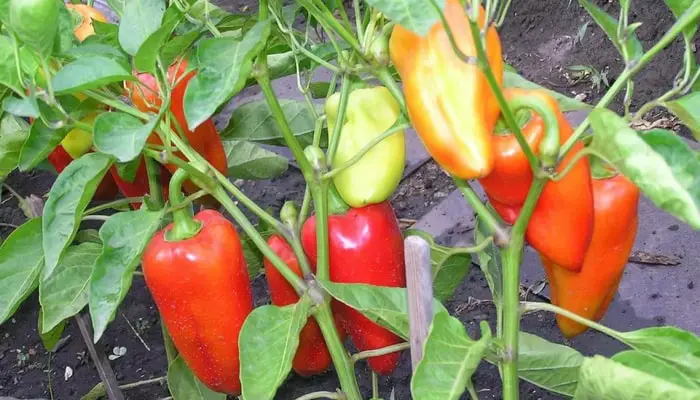
Peppers, like many other fruits, change color as they mature. If you harvest the pepper before it has fully matured, it may not turn red. In such cases, the pepper will remain green or yellow, depending on its variety.
There are two options for pepper maturity:
- Technical: It is also called harvest maturity. From the moment of formation of the ovaries to technical ripeness, 40-45 days pass. At this stage, the bell peppers do not yet acquire their full-fledged varietal properties, but are already both quite ready for eating.
- Biological: It occurs during the period of seed ripening, and the bell peppers acquire bright varietal characteristics.
From technical to biological ripeness takes 3-4 weeks. All this time, the pepper can be collected and eaten, canned, added to salads and all kinds of dishes. But it is during this last month that the vegetable accumulates a maximum of useful substances, sugars, trace elements.
Biologically ripe pepper differs from technically ripe peppers not only in appearance – color, but also in usefulness. Red pepper is healthier than unripe green pepper.
Look carefully at the package with seeds – it should indicate the dates of biological maturity and color.
Pepper has its own ripening period, which is indicated on the seed package, and on average it is approximately 90-150 days from the first seedlings. It is necessary to calculate the estimated ripeness and patiently wait for this moment.
Depending on the variety, pepper can ripen 90-150 days from full shoots, and sometimes longer. Perhaps we are just in a hurry, and we just need to wait a bit.
In order to ensure this for the pepper plant, the peppers must be sown in good time.
At the beginning of March, the peppers must be cultivated indoors as cuttings. After the last frost, they have to go outside. Only then can you be sure that the pepper plant has enough time to grow red peppers.
Ripening Stages of Peppers
Here are the general ripening stages for fresh green peppers:
- Green pepper: These immature peppers are unripe and have tender skin. They will turn red as they mature.
- Red pepper: These peppers are fully ripe and have tough red skin. The interior is still green, but the skin has turned red.
- Orange pepper: These peppers are fully ripe but have an orange coloration to their skin. The inside is still green, but the flavor has developed into that of red or yellow pepper.
| Ripening Stage | Description |
|---|---|
| Green | Immature, unripe pepper with a crunchy texture and little to no sweetness. Often used for pickling, cooking, or frying. |
| Turning | Pepper starts to change color and may develop some sweetness. Can be consumed at this stage, but flavor will be less developed than in later stages. |
| Partially Ripe | Pepper has developed more sweetness and flavor, but is not fully mature. Some varieties may be consumed at this stage, but others may need to ripen further. |
| Ripe | Pepper has reached full maturity and developed its characteristic color and flavor. Can be eaten raw or cooked, and may be sweeter or spicier depending on the variety. |
| Overripe | Pepper has become soft and may start to wrinkle or rot. Flavor may be less desirable than in earlier stages. |
| Dried | Pepper has been dried out and can be used for seasoning or grinding into powder. Flavor and heat level may be more concentrated than in fresh peppers. |
3. Unfavorable Environmental Conditions
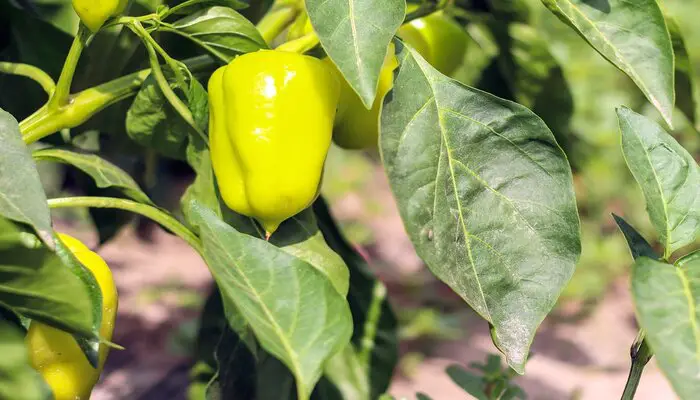
Pepper is very sensitive to changes in environmental conditions, and if something is wrong, it can completely drop flowers and ovaries, refusing to bear fruit.
| Unfavorable Environmental Conditions | Effects on Pepper Ripening |
|---|---|
| Low Temperatures | Peppers need warm temperatures to ripen properly, and temperatures below 60°F (15°C) can slow down or halt the ripening process. |
| Lack of Sunlight | Peppers need plenty of sunlight to produce the pigments that give them their characteristic colors. Lack of sunlight can result in underdeveloped or uneven coloration. |
| Water Stress | Lack of water or irregular watering can cause stress to the plant and prevent proper fruit development. This can result in small, underdeveloped, or misshapen fruits that may not ripen properly. |
| Nutrient Deficiencies | Peppers require a balanced supply of nutrients, particularly nitrogen, phosphorus, and potassium, to support healthy growth and fruit development. Deficiencies in these nutrients can result in poor fruit quality. |
| Overcrowding | Overcrowding can limit access to sunlight, nutrients, and water, which can reduce fruit quality and yield. This can result in underdeveloped or poorly ripened fruits. |
Unfavorable environmental conditions under which the pepper does not turn red:
Temperature
Temperature is also a contributing factor in red pepper coloration. Suppose a red pepper is exposed to high temperatures for an extended period of time (over 104°F). In that case, it may become blanched or white due to chlorosis (a deficiency in chlorophyll). Chlorosis results in the loss of color because the plant cannot produce fluorine compounds correctly.
An unstable summer, when a period of prolonged drought is replaced by protracted rains or intense heat is replaced by significant cooling, does not contribute to the ripening process.
It happens that underdeveloped small fruits suddenly begin to turn red. Or vice versa, the onset of biological ripeness is delayed for a week, or even a month. In order for the pepper to develop correctly and on time, the thermometer should be above 71°F (22°C) during the day, and at least 59°F (15°C) at night.
Pepper grows well and ripens at 64-86°F (18-30°С). The pepper fruits do not ripen if the weather is cool, when the thermometer drops to 53°F (12-13 °С). A thermophilic culture at such temperatures simply stops growing. If the heat is set at 95°F (35 °C), the pepper bushes quickly dry out.
Table with different varieties of peppers and their ripening temperature
| Variety of Pepper | Ripening Temperature Range |
|---|---|
| Bell Pepper | 70°F to 80°F (21°C to 27°C) |
| Jalapeño | 70°F to 90°F (21°C to 32°C) |
| Serrano | 75°F to 85°F (24°C to 29°C) |
| Habanero | 80°F to 90°F (27°C to 32°C) |
| Poblano | 65°F to 80°F (18°C to 27°C) |
| Thai Chili | 80°F to 95°F (27°C to 35°C) |
| Cayenne | 70°F to 80°F (21°C to 27°C) |
| Anaheim | 75°F to 85°F (24°C to 29°C) |
| Scotch Bonnet | 80°F to 90°F (27°C to 32°C) |
| Cherry Pepper | 70°F to 80°F (21°C to 27°C) |
| Banana | 70°F to 85°F (21°C-29°C) |
| Habanero | 80°F to 85°F (27°C-29°C) |
Sunlight
Peppers need plenty of sunlight to ripen properly. If the plant doesn’t receive enough sunlight, the pepper crop may not turn red. Pepper grows on the condition that it is illuminated during the day for at least 12 hours. If the daylight hours are too long – more than 14 hours, fruit ripening can also be disturbed.
Paradoxically, too much light will even harm the plant. Pepper belongs to the “short day” crops and produces the best yields when daylight hours last no more than 12 hours.
If the peppers don’t get enough sun, it will survive but will probably not bear any crop and if it does bear any it will only be green color.
But, at the same time, a sufficient amount of ultraviolet radiation must fall on the leaves and pepers so that they form and ripen normally.
If the peper grows in the shade and stretches without releasing flowers, gardeners recommend installing reflective screens that will give more light, or ultraviolet lamps.
The light day for pepper should be at least 10-12 hours, and the optimal one 14 hours. Moreover, the lighting intensity should be sufficient: light of 30-40 thousand lux is considered optimal.
It is best if they get a little break from the sun at lunchtime, otherwise the pepper plant may get sunburned.
Improper watering
Overwatering is one of the common causes of pepper plants that don’t turn red. To ensure your peppers get the consistent moisture they need, give an inch of water per week rather than going overboard.
If water is still being lost from the plant’s soil surface, adding compost or other organic matter may be necessary to boost water retention.
Problems with growth, ripening and fruiting in pepper arise if it is watered with cold, not settled water.
The method of watering also affects the development of pepper. Water should not be allowed to get on the foliage and stems, it is poured only under the root.
It is very important to maintain a balance here, because the vegetable does not tolerate both drought and excessive watering. Water should be warm, settled. It is desirable that water does not fall on the leaves when watering.
Fruiting peppers are watered once every 2 weeks, and so that the moisture does not dry out, the soil is loosened or mulched.
Overcrowding
If the pepper bushes are planted too densely and block each other’s light, the fruits are in no hurry to ripen, they do not turn red, as they do not have enough nutrition.
Like any other vegetable crop, pepper requires compliance with the rules of planting. If the plants are too dense, they will quickly deplete the soil and block each other’s light.
Therefore, it is necessary to maintain a distance between rows of at least 70 cm. At the same time, tall plants are planted 40 cm from each other, lower ones 30–35 cm.
4. Potassium Deficiency
Potassium is one of the main elements for the quality development of pepper. This is timely flowering, high-quality ovary and timely maturity of fruits. If there is not enough potassium, the plant’s development is delayed and it looks very bad.
Pepper “with great appetite” absorbs potassium from the soil. It is necessary for its full growth, timely flowering, ovulation and ripening of pepper fruits.
And when there is not enough potassium, the bell pepper fruits will stop ripening or will ripen unevenly. Lack of potassium can affect the appearance of the plant. Holes with yellowed edges appear on the lower leaves, and the upper leaves turn yellow in places.
Feeding with wood ash or fertilizers that contain potassium. Feed the bushes during the ripening of green peppers (per bucket of water – a teaspoon of potassium sulfate; per bucket of water – 2 teaspoons of potassium salt and superphosphate each; pour 2 teaspoons of ash under each bush).
5. Agricultural Mistakes
Root damage
This situation can be observed with the seedling method of cultivation. If the roots are damaged during the transplantation of seedlings, this can have an extremely negative effect on the entire subsequent vegetation of the plant.
Pepper with damaged roots recovers for a very long time, the bush will lag behind in development, the fruits will not have time to ripen.
Pepper seedlings are transplanted only by the method of transshipment with a lump of earth. We should plant in the garden in the same way, trying not to touch the roots at all. Because accidentally broken roots can become a factor in growth retardation, and therefore, ripening is delayed.
Careful picking and transplanting pepper seedlings helps to prevent the problem. It is performed exclusively by the method of transshipment – the seedlings are removed from the planting container and moved to a new place along with a clod of soil.
It is advisable not to touch the roots at all during transplantation.
Wrong fertilizing technique
One of the reasons why pepper does not ripen is the wrong way of fertilizing. Pepper reacts negatively to an excess of nitrogenous fertilizers.
Plants, instead of directing their forces to the ripening of fruits, increase their green mass. Nitrogen is applied before the beginning of summer; during flowering and fruiting, it is contraindicated.
The lack of potassium also negatively affects the ripening of fruits – with its deficiency, peppers may not ripen at all. A similar situation is usually observed on soils in which there is a lot of sand and peat. Calcium deficiency is also dangerous, which is treated with wood ash.
Pepper needs calcium fertilizer at any stage of ripening. Its deficiency is well filled with wood ash. Phosphorus is added at the moment of fruit formation, and calcium nitrate is added 2-3 times during the entire growing season, which prevents decay.
Try using a lower fertilizer concentration or avoiding fertilizing if your pepper plants are young or newly transplanted. Fertilizing later in the season may also work better for most plants.
Improper planting of seeds.
Sowing in the soil can be carried out only after the cessation of temperature fluctuations, warming up the soil and establishing stable heat.
Unsuitable soil
Pepper needs light fertile soils, heavy clay soils, as well as overly acidic soils are not suitable for it. So that the pepper does not slow down the ripening process, organic matter and dolomite flour are added to the beds, which deoxidizes the soil.
Excess inflorescence
Their abundance negatively affects the yield and can cause a delay in the ripening of peppers – they do not have time to either reach a large size or turn red.
Thinning the inflorescence helps to avoid the problem. It is recommended to cut off the first inflorescence located at the branching point of the stems. Only one bud, the most powerful, should remain in the internode. Otherwise, the bush will not have enough energy to ripen all the peppers.
So that the bush does not form too many inflorescences, you need to remove the flower that appears first at the place where the branches branch. It is also called a crown.
Sometimes there are several crown buds. All of them must be removed, otherwise the plant will not branch well and spend a lot of energy on these buds.
At the nodes, one strongest bud should be left. You should also not leave all the ovaries on the bush: they will only slow down the development of each other.
Common Mistakes to Avoid when Ripening Peppers
If you’ve tried to grow peppers and they won’t turn red, you can try a few things. Unfortunately, not all problems with peppers can be solved quickly. However, following simple tips will help troubleshoot the issue and get your peppers growing how you want them to.
A few things can prevent the red coloration in peppers, so avoid these mistakes to ensure the best results:
1) Not providing enough light: The first step in bringing red color in peppers is exposing them to light. If they don’t receive enough sunlight, their chlorophyll will not convert into anthocyanin, responsible for their vibrant red color. So ensure your peppers have plenty of exposure to natural light, either by leaving them outside on a sunny day or under a fluorescent light.
2) Overwatering: Another mistake that can prevent peppers from turning red is overwatering them. Too much water will make the pepper’s green leaves transparent and cause the pigment to leach out. So give water when needed and dry them off well after watering.
3) Wrong variety: Not all varieties of peppers turn red. Some may remain green or have a yellow hue. It’s essential to select a variety known for its brightly colored pepper, like an orange bell pepper or a fiery jalapeno.
4) Using the wrong type of soil: Different types of soil will help or delay the growth of plants according to their pH levels. Acidic soils will neutralize the acidity produced by onions and other vegetables, leading to better growth and a deeper red coloration.
Conclusion
It can be frustrating when your peppers don’t turn red after being planted in the ground. There are a few things that you can do to help get your peppers turning red sooner.
Try watering them more often, fertilizing them, and putting them in direct sunlight for extended periods. If you still need to see any change after trying these tips, it may be time to consult a professional.
Frequently Asked Questions
There are a few tricks you can use to ripen your peppers faster: 1.Put them in a sunny spot. This will help them reach their optimum red color.
2.Place them in the fridge. This will slow down the rate at which they turn red, but it won’t stop them from going bad altogether.
Yes, you can force your green peppers to turn red by exposing them to ethylene gas, which is naturally produced by ripe fruits. To do this, place your green peppers in a paper bag with a ripe apple or banana for a few days until they turn red.
Peppers in a greenhouse may not turn red if they are not receiving enough sunlight, as sunlight is essential for triggering the ripening process. Additionally, if the greenhouse is too humid, it may prevent the peppers from ripening properly, as high humidity can cause the fruit to rot before it fully ripens.
Peppers can take anywhere from a few weeks to several months to turn red, depending on the variety, growing conditions, and stage of development. Generally speaking, peppers will begin to turn red around 3-4 weeks after reaching full size.
You need to do a few things to turn your pepper red: Place them in a sunny spot and water them regularly. Store it in a dark, cool place. Pick it when their color starts vanishing.

